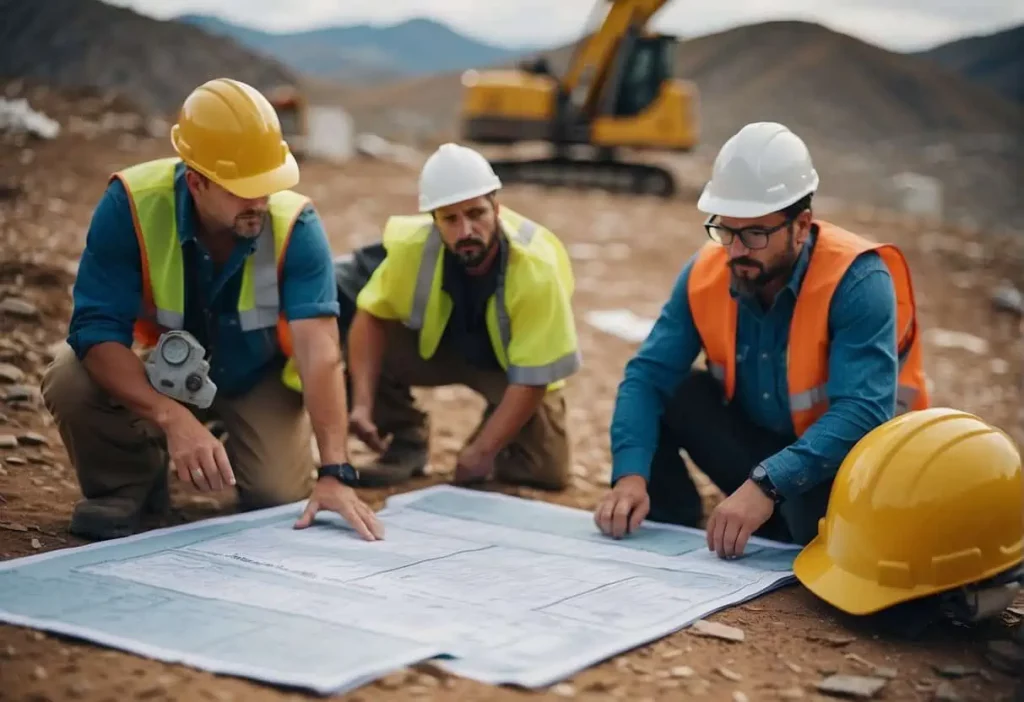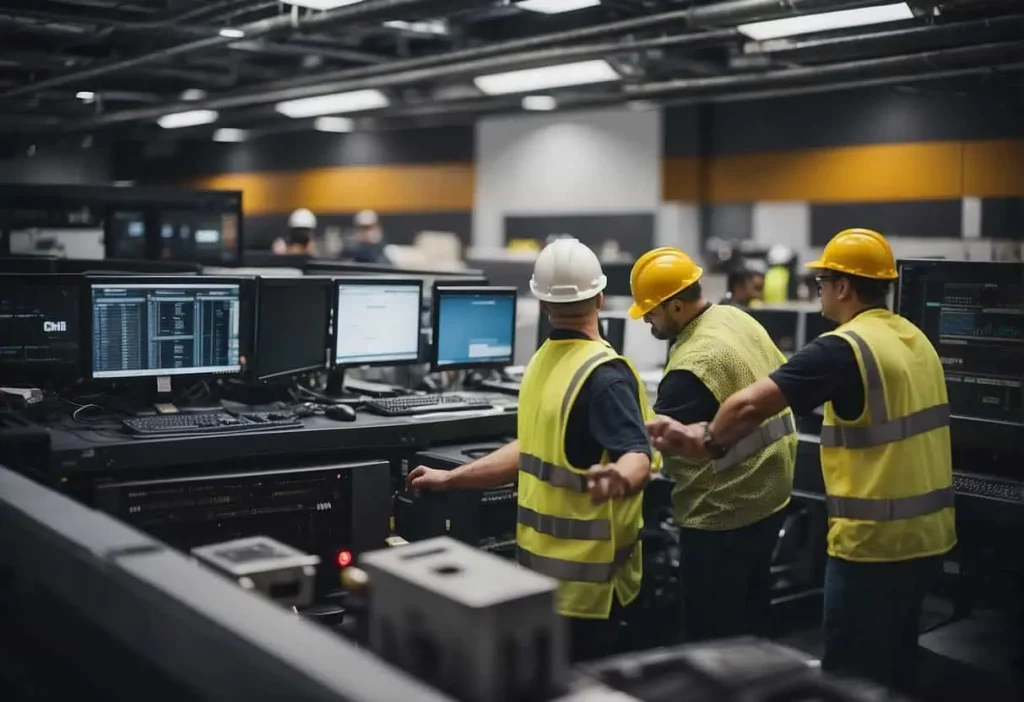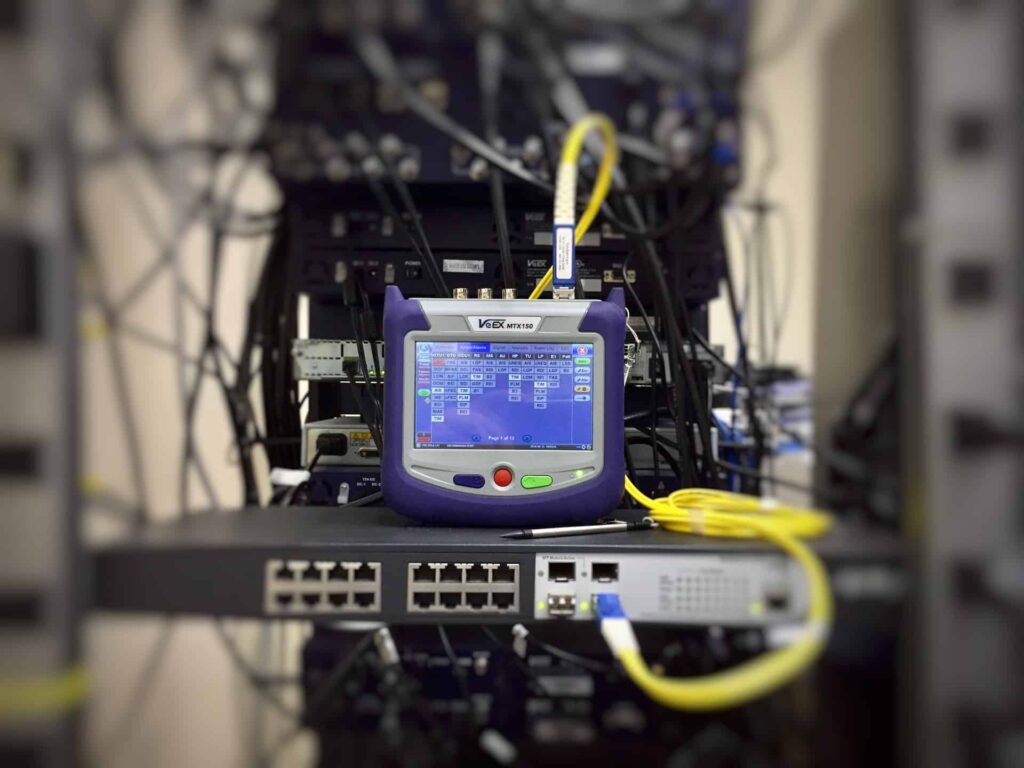Data centers stand as the backbone of modern digital infrastructure, housing the critical servers and hardware that support an ever-growing pool of data and connectivity demands. As the reliance on technology surges, so does the need for robust data centers, making their construction a crucial and frequently undertaken project across the globe. However, building these complex facilities is fraught with challenges that developers and construction teams must navigate. These range from the initial stages of site selection and land acquisition, which are vital for accessibility and scalability, to the intricacies of design and planning that set the groundwork for a successful build.
Building a data center goes beyond erecting structures; it entails embedding advanced technology within their very framework. Technological integration poses significant hurdles as it must not only meet current demands but also remain agile enough to adapt to future advancements. Simultaneously, construction teams face practical bottlenecks such as supply chain management, which has become even more unpredictable in the wake of global disruptions like the pandemic. Moreover, the sector is bound by strict environmental and regulatory compliance standards, which add additional layers of complexity to the construction process.
Key Takeaways
- Data center construction fulfills the growing demand for digital infrastructure.
- Challenges encompass planning, technological integration, and regulation adherence.
- Projects must anticipate future industry dynamics to ensure long-term viability.
Industry Overview

The data center industry is witnessing significant transformation driven by an escalation in demand and rapid technological evolution.
Growth of Data Center Demand
The relentless upsurge in data center demand is propelled by the global digitalization trend and the exponentially growing needs of cloud computing, Big Data analytics, and AI applications. Data center growth is not merely a trend but a necessity as enterprises and consumers alike are becoming increasingly reliant on data-centric services. Hyperscale data centers, large-scale facilities designed to efficiently support robust and scalable applications, are becoming more prevalent to meet this explosive data center demand.
Evolution of Data Centers
Data centers are continually adapting to meet the challenges posed by modern workloads and services. This evolution is characterized by advances in technology that cater to the need for greater computing power and storage capacity. The industry is actively integrating AI to optimize facility operations and improve energy efficiency. Moreover, the architectural design of data centers is progressing to incorporate modularity and scalability, allowing for rapid expansion as demand dictates.
Site Selection and Land Acquisition

In the development of data centers, site selection encompasses a complex mix of factors including location, land availability, and cost, as well as zoning and permitting issues. These decisions are pivotal in laying the groundwork for a facility that meets both technical requirements and economic objectives.
Importance of Location
Choosing an optimal location is crucial for data center functionality and efficiency. Factors such as proximity to users to minimize latency, access to robust power sources, and a location that’s less prone to natural disasters play a significant role in the site selection process. The location must also provide the necessary connectivity and bandwidth to support the data center operations.
Real Estate Costs and Availability
Real estate costs are a significant portion of the capital investment for a data center. As demand for data capacity escalates, so does the competition for suitable land, driving up prices. Developers must balance the cost of land acquisition against the prospective data center’s operational efficiency and capacity to yield return on investment. Availability of developable land, particularly in urban areas, is increasingly scarce, representing a growing challenge.
- Land Costs: The financial outlay to secure land for development can vary widely by region.
- Availability: Land must also be sufficient in size to accommodate the data center with room for potential expansion.
Zoning and Permits
Navigating zoning laws and obtaining the necessary permits is an essential part of acquiring land for data centers. These legal frameworks dictate the types of developments permissible within certain areas and ensure that the facility will conform to local regulations and community standards. Developers must:
- Identify zoning regulations: Ensure the selected location is zoned for such technical and industrial use.
- Secure permits: Acquire all required building and operational permits, a process that can often be complex and time-consuming.
Design and Planning

The design and planning phase is crucial in data center construction. It sets the foundational standards for infrastructure capabilities, efficient scalability, and sustainability measures tailored to meet current and future demands.
Infrastructure Requirements
Data center infrastructure is comprised of intricate systems that ensure operational efficiency and reliability. Critical components include electrical power systems, cooling mechanisms, and network connectivity. Each element must comply with industry standards and codes to guarantee safety and performance. For instance, the electrical infrastructure must provide consistent power with backup solutions in place to mitigate downtime risks.
Capacity and Scalability Planning
A primary challenge in data center construction is predicting future capacity needs. Data centers must be designed with flexible scalability in mind, allowing for expansion without significant overhauls. It involves an initial assessment of the current demand, projected growth, and technological trends that influence data volume and processing power. For scalability, one must consider the space layout, power supply, and cooling systems’ adaptability to support additional workloads.
Incorporating Sustainability
Sustainability in data center design is increasingly important. Environmental considerations such as energy-efficient cooling systems and the use of renewable energy sources are vital. Sustainable planning also encompasses the choice of materials and equipment with lower environmental impacts and the implementation of energy conservation measures. Sustainable practices help to minimize carbon footprints and operational costs, aligning with global objectives for greener technologies.
Meeting these challenges requires a cross-disciplinary approach, integrating expertise from various fields, including architecture, engineering, and IT, to develop data centers that are efficient, scalable, and sustainable.
Building Challenges
Data center construction is a complex and demanding process, facing unique challenges that can significantly affect the timeline and cost of projects.
Materials Supply and Costs
The procurement of construction materials is a critical step in building data centers. Volatility in supply chains can lead to disruptions and delays, impacting the overall cost of materials and the project timeline. For instance, the cost of steel—an essential material in these constructions—can fluctuate widely, making budgeting a challenge.
- Key materials: Steel, concrete, aluminum
- Impact of volatility: Price fluctuations, project delays
Labor and Skilled Workforce
The demand for skilled labor is paramount in the data center construction industry; it requires specialized knowledge and expertise. Any shortages in this workforce can lead to significant delays and may also affect productivity levels on-site. Data center projects often compete with other industries for this limited skilled labor pool.
- Necessary skills: Electrical, HVAC, network installation
- Challenges:
- Shortage of qualified personnel
- Training and retaining talent
Project Management
Project Management is crucial for the streamlined execution of a data center build. Coordinating between different stakeholders and managing resources effectively are integral parts of the process. Any lapses in project management can cause setbacks, escalating costs, and extended timelines.
- Key aspects:
- Resource allocation
- Timeline adherence
- Potential issues:
- Miscommunication leading to errors
- Inadequate risk management
Technological Integration
As data center construction evolves to meet increasing demand and complexity, integrating advanced technology systems is both critical and challenging. This section delves into the intricacies of server and networking installation, cooling systems, and energy management, which are cornerstone considerations for modern data center infrastructure.
Server and Networking Installation
At the core of a data center lies the deployment of servers and networking equipment. Proper racks placement and cabling ensure efficient use of space and contribute to the life and performance of these units. It’s essential to plan for future growth and scalability by installing modular and flexible server configurations. Technical teams must also navigate through complex networking topologies to ensure unimpeded data flow and minimal latency.
- Cabling: Structured cabling systems with clear labeling for easy identification.
- Servers: Installing in temperature-controlled environments with adequate airflow.
Advanced Cooling Systems
The rise of high-density server installations has necessitated more advanced cooling solutions. Data centers adopt various strategies, from traditional CRAC units to more innovative liquid cooling and immersion cooling, to manage heat dissipation efficiently. The integration of these systems is a delicate balance between effectiveness and cost.
- Cooling Strategies:
- Air-based cooling (CRAC, CRAH)
- Liquid cooling solutions
- Immersion cooling techniques
Energy Efficiency and Power Consumption
The dual concerns of energy efficiency and power consumption are paramount given the significant electrical demand of data centers. Designing with an aim toward energy conservation, such as deploying Energy Star-rated equipment and utilizing renewable energy sources when possible, is a proactive step. The precise measurement and monitoring of power usage, known as PUE (Power Usage Effectiveness), guide operators in optimizing consumption and reducing overhead.
- Energy Management Practices:
- PUE monitoring
- Renewable energy integration
- High-efficiency power supply units (PSUs)
Effective technological integration in data center construction demands comprehensive planning, robust management, and continual adaptation to stay ahead of the curve in a rapidly advancing field.
Operational Challenges
In the complex ecosystem of data center construction, operational challenges center around ensuring continuous service, protecting critical data, and integrating cutting-edge technologies to meet the evolving demands.
Maintaining Power and Uptime
Data center operators prioritize the consistent delivery of power and the achievement of high uptime. The Uptime Institute’s Tier Standards serve as the benchmark for reliability, and any power outage is a significant breach of operational protocol. It is critical to implement redundant power supply systems and regularly test backup generators to ensure uninterrupted service.
- Redundancy: A+B power configuration
- Testing: Biannual scheduled power infrastructure tests
Security and Data Protection
Security is paramount in protecting against breaches that can compromise client data and critical infrastructure. Secure access controls, both digital and physical, are compulsory to safeguard against unauthorized access. Regular security audits and adherence to regulatory standards are essential to maintain trust and operational integrity.
- Access Controls: Multi-factor authentication, biometric access
- Audits: Quarterly security compliance checks
Adapting to New Technologies
The relentless pace of technological advancement presents both opportunities and challenges. Data center operators must embrace AI and other innovations to enhance efficiency and predictive maintenance while ensuring compatibility with existing systems. The balance between adopting new solutions and maintaining existing operations is delicate but essential for forward-thinking data centers.
- AI Integration: AI-driven predictive analytics for systems management
- Innovation Management: Annual review of emerging tech compatibility
Environmental and Regulatory Compliance
Constructing data centers today requires strict adherence to environmental and regulatory standards. These compexities are significant due to the pressing need for sustainability, climate change mitigation, and robust infrastructure to withstand natural disasters.
Responding to Climate Change
The construction of data centers must consider their carbon footprint and greenhouse gas (GHG) emissions. Data center operators are under increasing pressure to implement energy-efficient designs and to utilize renewable energy sources. Compliance with evolving regulations targeting GHG emissions is both a challenge and a necessity.
- Energy Performance: Improved energy performance is vital, as data centers consume a substantial amount of electricity.
- Renewable Energy: Integration of renewables is increasingly mandated by regulatory bodies.
Natural Disaster Preparedness
Data centers must withstand environmental disruptions caused by natural disasters. This includes strategic site selection, structurally resistant design, and comprehensive disaster recovery planning.
- Site Selection: Choosing locations with reduced risk of flooding, earthquakes, and other natural events.
- Structural Design: Buildings must be designed to endure specific regional threats.
Backup Power and Redundancy Requirements
Reliable operations in data centers demand backup power solutions and redundancy to ensure uninterrupted service. Regulatory standards often specify the necessary levels of redundancy and backup systems to cope with power outages.
- Backup Power Supplies: Implementation of uninterruptable power supply (UPS) systems and generators is mandated for operational reliability.
- Redundancy Levels: Regulations may dictate N+1 or 2N redundancy to guarantee continuous uptime during power failures.
Supply Chain Management
Effective supply chain management is critical for timely and on-budget completion of data center construction projects. It involves taking proactive measures to address constraints, building resilience into the supply chain, and maintaining strong relationships with vendors and partners.
Addressing Supply Chain Constraints
Supply chains in the data center construction industry are experiencing constraints due to a high demand for materials and the intricate nature of these projects. To mitigate these challenges, companies prioritize diligent planning and adopt strategies such as just-in-time delivery to streamline the availability of essential materials.
- Materials: Projects often require specific materials unique to data center builds, necessitating strategic sourcing.
- Timing: Delays can be minimized by scheduling deliveries in alignment with project timelines.
Developing a Resilient Supply Chain
Building a resilient supply chain is essential to withstand disruptions and adapt to changing market conditions. Data center constructors are emphasizing diversification of their supplier base and investment in predictive analytics to anticipate supply chain disruptions.
- Diversification: Reduce reliance on a single supplier to limit vulnerability.
- Predictive Analytics: Utilize data-driven tools to forecast potential supply chain issues, allowing for preemptive action.
Vendor and Partner Relations
Strong relationships with vendors and partners are fundamental to effective supply chain management in data center construction. These relationships are grounded in ongoing communication, transparency, and contract adherence, which can lead to better risk mitigation and reliability.
- Communication: Regular updates and open dialogue help in aligning expectations and addressing issues promptly.
- Transparency: Sharing project roadmaps and forecasts with vendors ensures that material supplies are in sync with construction requirements.
Innovations in Construction
Amidst evolving challenges, the data center industry has seen significant advances in construction methodologies. These innovations aim to streamline processes, enhance sustainability, and embrace cutting-edge materials to meet the ever-growing demand for data centers.
Prefabrication and Modular Builds
Prefabrication refers to the process of assembling components of a structure in a manufacturing site, which are then transported to the construction location. The technique offers numerous benefits such as speed in construction and reduced waste, making prefabrication a prime example of construction innovation. Modular builds, on the other hand, consist of data center units that are built off-site and can be easily expanded by adding more modules. This approach allows for a flexible and scalable design that can adapt to the changing needs of data center operators.
- Advantages:
- Scalability
- Reduced construction time
- Control over manufacturing environment
- Less on-site disruption
Utilizing Renewable Energy Sources
Data centers are increasingly utilizing renewable energy sources to power operations and reduce their carbon footprint. Solar, wind, and even nuclear power are considered for on-site generation, while some facilities opt for purchasing renewable energy credits or directly tapping into renewable power grids. This shift is not only an environmental move; it’s a strategic one that enhances the long-term sustainability and operational cost efficiency of data centers.
- Examples:
- Solar panels integrated into the facility design
- Wind turbines used to supplement power needs
- Partnerships with local renewable power plants
New Construction Material Technologies
Innovation extends to new construction materials which offer enhanced performance and durability. Advanced materials like high-performance concrete and steel with improved thermal characteristics are finding their way into data center builds. These materials help maintain optimal environments for hardware while reducing cooling costs. They also add to the building’s overall resilience—a critical factor in the ongoing reliability of data center operations.
- Impact:
- Increased building lifespan
- Better thermal management
- Enhanced structural strength
Industry Dynamics
The landscape of data center construction is evolving due to an increase in colocation services, a competitive provider market, and the influence of global events on operations and planning.
Colocation and Large-Scale Projects
The demand for colocation facilities, where multiple customers locate network, server, and storage gear and interconnect to a variety of telecommunications and other network service providers, is soaring. These projects require large-scale construction efforts that not only accommodate immediate needs but also future scalability. The challenge lies in delivering these massive, complex projects on time, without overshooting budgets and while maintaining operational excellence.
Data Center Provider Market
The market of data center providers is marked by intense competition. Providers differentiate themselves through innovative designs, energy efficiency, and rapid deployment capabilities. Those who manage to optimize the construction process for efficiency and speed without sacrificing quality can gain a significant edge. However, a shortage of skilled professionals in critical areas like project management is making it increasingly difficult to keep up with the market’s fast-paced evolution.
Impact of Global Events
Global events, such as economic fluctuations, trade disputes, and pandemics, play a significant role in data center construction. They can cause supply chain disruptions, leading to delays in obtaining essential materials and equipment. Furthermore, these events might influence energy prices and availability, which are critical considerations for data center operations. Providers must adeptly navigate these dynamic conditions to avoid construction delays and cost overruns.
Frequently Asked Questions
In addressing the intricacies of data center construction, several frequently asked questions arise that delve into challenges, infrastructure components, operational concerns, energy efficiency, security, and cooling strategies.
What is the most critical challenge faced during data center construction?
The most critical challenge often centers around selecting a suitable location that balances the availability of land, compliance with zoning regulations, and the proximity to necessary utility and network infrastructure. This is critical to ensuring optimal performance and connectivity.
What primary components make up the infrastructure of a data center?
The core infrastructure of a data center includes compute resources (servers), storage systems, networking equipment, power distribution systems, backup power solutions, cooling mechanisms, and physical security features. These ensure that data center operations are reliable and efficient.
What factors contribute most to data center operational failures?
Operational failures can arise from power outages, hardware malfunctions, software errors, network connectivity issues, and human error. Efficient design and proactive management are necessary to minimize these risks.
During construction, how is energy efficiency addressed in data centers?
Energy efficiency in data centers during construction is achieved by implementing design strategies like advanced insulation, efficient cooling systems, and the integration of energy-efficient power systems that reduce the overall carbon footprint and operational costs.
In the construction phase, how are data center security concerns mitigated?
During construction, security concerns are mitigated by incorporating multi-layered physical security measures such as biometric access controls, surveillance systems, and secure barriers. Additionally, planning for cybersecurity measures starts in the construction phase to ensure a secure digital infrastructure post-completion.
What strategies are employed to handle the cooling requirements of a data center?
To handle cooling requirements, strategies like hot aisle/cold aisle layouts, liquid cooling systems, and the use of outside air are employed. These are engineered to manage the heat generated by high-density computing equipment efficiently.
Last Updated on February 12, 2024 by Josh Mahan


![Best data center racks Best data center racks [buyer’s guide]](https://cc-techgroup.com/wp-content/uploads/2021/08/best-data-center-racks-1024x576.jpg)

